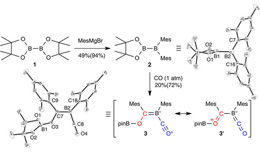Research Abstract
ジボラン(4)試薬を用いたイソニトリル炭素-窒素三重結合の簡便な切断法
Facile scission of isonitrile carbon–nitrogen triple bond using a diborane(4) reagent
2014年6月26日 Nature Communications 4 : 4245 doi: 10.1038/ncomms5245

三重結合の結合エネルギーが高いにもかかわらず、遷移金属試薬や触媒は、概して3つの結合全て(σ 結合1つとπ結合2つ)の開裂に効果的である。最近、遷移金属を使わず、典型元素化合物を用いる単結合開裂の化学が、急速に進展しつつある。しかし、遷移金属化合物を用いない三重結合の開裂については、それほど研究が進んでいない。今回我々は、非対称ジボラン(4)化合物が室温で一酸化炭素およびtert-ブチルイソニトリルと反応可能であることを報告する。特にtert-ブチルイソニトリルとの反応の場合、遷移金属なしで炭素-窒素三重結合が完全に開裂した生成物が得られた。生成物の構造はX線結晶構造解析、13C標識を用いた13C NMR分光法、DFT計算によって確認された。また、DFT計算によって詳細な反応機構が明らかになり、炭素-窒素三重結合開裂成功のカギは、中間体の1つにおける求核性の高い窒素原子の存在によることが分かった。
浅川 博祈1, Ka-Ho Lee2, Zhenyang Lin2 & 山下 誠1
- 中央大学大学院 理工学研究科 応用化学専攻
- 香港科学技術大学 化学科(香港)
Transition metal reagents and catalysts are generally effective to cleave all three bonds (one σ and two π) in a triple bond despite its high bonding energy. Recently, chemistry of single-bond cleavage by using main-group element compounds is rapidly being developed in the absence of transition metals. However, the cleavage of a triple bond using non-transition-metal compounds is less explored. Here we report that an unsymmetrical diborane(4) compound could react with carbon monoxide and tert-butyl isonitrile at room temperature. In the latter case, the carbon–nitrogen triple bond was completely cleaved in the absence of transition metal as confirmed by X-ray crystallographic analysis, 13C NMR spectroscopy with 13C labelling and DFT calculations. The DFT calculations also revealed the detailed reaction mechanism and indicated that the key for the carbon–nitrogen triple-bond cleavage could be attributed to the presence of nucleophilic nitrogen atom in one of the intermediates.

